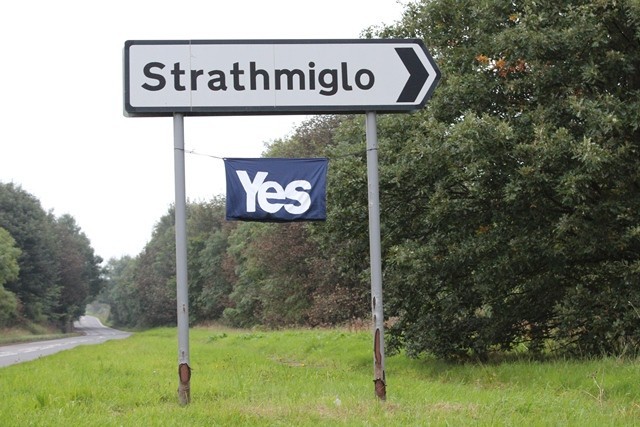
A household in Gateside, Fife. Photo by Anna Chworow.
It is Thursday, 18th September, and Scotland is facing its biggest democratic vote in the country’s history – the independence referendum. If the majority of the electorate responds ‘yes’ to the question ‘Should Scotland be an independent country?’, the nation, which is currently a part of the union of the United Kingdom, will become a sovereign state.
The debate started in 2011 with the launch of pro-independence Yes Scotland and pro-union Better Together campaigns. The polls, which a year ago showed merely 32 percent in favour of independence, with 49 percent of those being pro-union and 19 percent undecided, for the first time put the ‘Yes’ Campaign in the lead on 12th September 2014, with 49 percent favouring independence, 42 percent against, and only 9 percent undecided.
It has been a heated campaign, often portrayed as a grassroots effort of the ‘Yes’ camp versus a unionist stance favoured by the leading UK political parties. However, with promises of a fairer, more equal society, a written constitution (the UK doesn't have one), nuclear disarmament, and a pro-immigration stance, the ‘Yes’ Campaign has had strong support from the Scottish Green Party, the Socialist Party, and spearheaded by the Scottish National Party, which currently holds the majority in Scottish Parliament.

The independence debate covered a spectacularly wide range of issues. A passionate appeal in Edinburgh. Photo by Anna Chworow.

Yes campaigners coined a phrase: ‘Houses are voting yes, fields are voting no’, pointing to the promises of land tax and reform in independent Scotland which would primarily affect the big landowners. ‘No thanks’ sign in a field in Auchtermuchty, Fife. Photo by Anna Chworow.

Young people became fully engaged in the debate. A window posted in Edinbrugh. Photo by Anna Chworow.
In the meantime, pro-independence activists have managed to capture the hearts and imaginations on many voters in Scotland in a way that the unionist camp has not. Drawing inspiration from what are considered to be the fairer and more prosperous Nordic countries with high levels of democratic participation, many in Scotland became involved in the campaign at the grassroots level.
The Better Together campaign, renamed by its critics as the ‘Bitter Together’, emphasized economic uncertainties, potential increases in fuel and food prices, questions over currency, as well as Scotland's potential membership in the EU as an independent state. Many major banks and companies threatened that, should Scotland become independent, they would consider relocating their headquarters to England, and warned of the possible economic implications of such moves.

Green Yes supporter in Edinburgh. Photo by Anna Chworow.

Yes Campaign banner on approach to Strathmiglo, Fife. Photo by Anna Chworow
Arguments presented by both sides are difficult to take into consideration in just one breath. There are, however, two major achievements of the campaigns that are worth highlighting. First, the debate over a potential break-up of a 300-year-old union, a vote of historic significance, took place without a single act of violence. The worst reported incidents were the egging of a pro-union politician Jim Murphy by the ‘Yes’ camp protesters and the spray-painting of the ‘Yes’ campaign headquarters in Edinburgh with ‘No thanks’ and Nazi symbols. Many households, families and workplaces have been polarised by their views on independence, but united by their engagement in the debate and an obvious desire for the best outcome for Scotland.
What should also be highlighted is the unprecedented level of public engagement resulting from the debate. Twitter and Facebook have been flooded with heated discussions, with the #indyref hashtag mentioned over 2.6 million times in just the past 30 days. There have also been a record number of people registering to vote, with estimates suggesting as much as 97 percent of those eligible to vote have registered. There have been countless marches, blogs, canvassing events, cultural events, speeches, discussion circles and more. These images collected on Twitter provide a glimpse of the exciting times Scotland has experienced over the past two and a half years.
Lampost in North Queensferry. pic.twitter.com/79RGJo5Hpl
— David Greig (@DavieGreig) September 16, 2014
.@scotgp campaign for a Yes vote on Leith Walk in Edinburgh #indyref pic.twitter.com/n8Tq7Pt2TH
— Fiona Winchester (@FiWinchester) September 16, 2014
Loving this Portobello resident who has taken the time to share with his neighbours why he's #nothanks pic.twitter.com/ooHe25ZVHA
— Kezia Dugdale (@kdugdalemsp) September 16, 2014
Wonderful sunny Glasgow Great day for #LabourNo to be here.The UK needs Scotland.Lets stay together #bettertogether pic.twitter.com/4P46vlzAc5
— Kate Hoey MP (@hoeykateMP) September 11, 2014
This started with one guy tweeting, let's have a rally on Tuesday. Ordinary folk after work. It's huge! pic.twitter.com/0ay2SbCic4
— Dawn (@Dawnf1) September 16, 2014
Will the people of Scotland vote to stay or to go? The results of the referendum are to be announced by 7am tomorrow morning.






